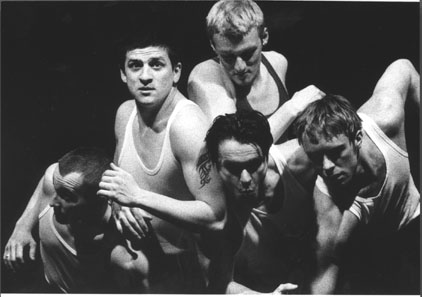 The
choreography and the fourth project by Branko Potocan was inspired by a
poem by the Slovenian poet Dragotin Kette. It’s a story about a suicide,
set into the contemporary urban environment with all its pressures and
the stress of living in a competitive society. “The tree took him in, and
he is no longer alone…Now he is swinging from its crown”. The
choreography and the fourth project by Branko Potocan was inspired by a
poem by the Slovenian poet Dragotin Kette. It’s a story about a suicide,
set into the contemporary urban environment with all its pressures and
the stress of living in a competitive society. “The tree took him in, and
he is no longer alone…Now he is swinging from its crown”.
The images of self-destruction and suicide are
sequenced in a quick-paced reflection on the helplessness of the individual
on one side and society on the other. In the opening scene, the dancers
enclose one of them in a circle, the scene then changes to the image of
urban hustle and bustle. The figure of a businessman with a cellular phone
and a black attache case who even walks the ceiling or the walls, as occasion
demands, represents blind scrambling after material goods; it is juxtaposed
against the character of a dreamy artist, writing Kette’s poem on the wall.
The third character is that of human being who fights repression against
all the odds as he tries to dodge the hurdles that hit you with full force
if your attention drops…Eventually, they all give in to the call of the
other world and swing out into their own respective private worlds, hanging
on the ropes/sheets. The quick pace of life is reflected in the dancers’
movements; they are sporadic, fast, rough and violent as well as quite
humane. Their technique and the stage props are typical of the Fourklor,
the choreography is clear-cut and unburdened with pre-determined technical
form. Scenic props (ropes, sheets hanging from the ceiling) are easily
seen as physical objects or frames of symbolic contents, as invisible chains,
ropes, and hurdles that are nonetheless always there in order to be defied,
overcome. The music, cyber trip-hop, the costumes and the lighting are
relevant to the theme as well.
The best qualities of this production, its clever
concept and unpathetic, soft melancholy mood sparkling with humour, leave
no doubt about the capability and knowledge of everyone in the group whose
new choreography offers an exceptionally openminded, unfettered and undistorted
reflection on human anxiety. Addressing self-destructive behaviour in a
society that ranks among those with the highest percentage of suicide in
Europe, is a socially relevant act and not all one to be approached lightly,
considering how easily it is stereotyped. Melancholy Thoughts work on different
levels: on the level of reality and in the context of a dream-life, the
flight. The black mesh which safely kept the public and the stage apart,
creating an illusory existence of “their suicidal reality” and “our world”,
was dropped on the audience, along with the ropes, at the close of the
performance. The boundary always remains imaginary, for in reality there
is none. Congratulations to the group for such excellence and let’s hope
other performances like it will follow.
Melancholy, but not pathetic
Tatjana Greif (Daily Magazine Dnevnik, 11th March
1998) |